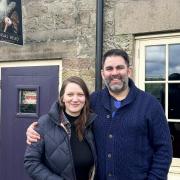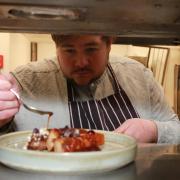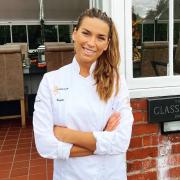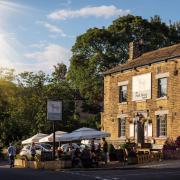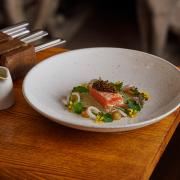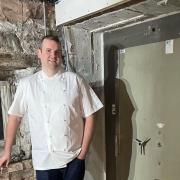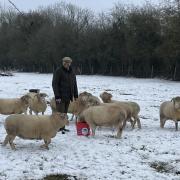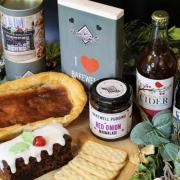Tucked away in the foothills of Stanage Edge is a small artisan cheese-making business run by James and Sophie Summerlin. Distinct and flavoursome, local Derbyshire cow’s milk is used to create a soft creamy cheese – the bloomy rind ‘Stanage Millstone’ as well as ‘Stanage Curd’.

Back in the harsh winter of 2013, with thick snow covering the hills of Hathersage, Sophie and James moved into Cow Close Farm, a smallholding that arguably had one welly still firmly set in the 1940s. This young couple were keen to get started and make the Cow Close into something incredibly special.
Home Sweet Home
The couple’s original aim was to make artisan food that was good quality with no additives. They started to look at all kinds of food but having researched the market discovered that there were very few cheese producers in Derbyshire. ‘We wanted to make a cheese that we enjoyed eating ourselves, but a variety that would not tread on any of our neighbouring producers’ toes,’ explains James.

The couple hadn’t always planned to have their own business. Originally from Hathersage, Sophie had met James at university and after graduation they followed the normal path of ploughing straight into their respective professional careers, living at the time in a renovated old cottage in Wilmslow. Sophie’s heart, however, was always in Hathersage, where her family had a small farm near where she lived as a child. Having persuaded James to move there, the couple started their new adventure. With ambitions to make artisan food, the farm provided the ideal opportunity. ‘Soon after moving to the farm, we started out on our cheese mission, and began applying for planning permission to build a creamery. It wasn’t an easy process but we finally got permission to convert an old sheep shed into our dairy premises and maturing rooms. We built a highly-insulated, hygienically-clad building inside the original building and started production in April 2016,’ says Sophie. This decision proved crucial, according to Sophie and James who cite their base in Derbyshire as key to their success. ‘Derbyshire is really foodie. There are so many small producers and restaurants doing great things. Many of these have been hugely supportive to us since we started.’
The Soft Choice
Further research showed that the softer the cheese, the sooner from ‘make’ to sale. ‘Harder cheeses take less time in the first instance to turn milk into cheese, but need much longer to mature, whilst the softer cheeses can take many man hours initially but can be sold relatively soon, if not the next day in some cases,’ explains James. ‘This helps with start-up businesses as it means you don’t have to make hundreds of kilos of hard cheese and leave it in a fridge to mature and develop before you can sell it. With so many different types of cheese to choose from and all with their own unique attributes, it was not an easy decision. This is also enhanced by the different milks from different herds. Every small-scale cheese is different to the next,’ he adds.

In the end, the choice of their particular cheese came from a combination of personal taste and practicalities. ‘We love Chaource and other soft bloomy rind cheeses. We wanted the cheese to look good in its packaging but also look distinctive on a cheeseboard. We also wanted to shape it like a millstone to mimic the heritage of the area’s past industry. There are millstones on our land and under Stanage Edge just above us. The millstone is also the emblem for the Peak District National Park,’ explains Sophie.
Humble Beginnings
While it’s common to borrow the odd bit of milk from your neighbour, Sophie and James took it to another level with their business and use milk from a neighbour’s herd of traditional black-and-white (Holstein-Friesian) cows mixed with some Brown Swiss. ‘The milk is collected in our 1,000 litre tank and driven the very short journey back to our farm. We then start the long process of making the millstones.’

The whole process is like a well-oiled machine, but originally the business started with more humble roots and, as with many small businesses, the kitchen table was at the forefront of the initial production. ‘We started making cheese in the home kitchen before we had finished creating our creamery,’ explains James. ‘The cheese was first launched at a very good local Christmas market and through local supportive retailers, mainly in Sheffield. We did most of the building works on the creamery ourselves and bought nearly all of our equipment second hand from a cheesemaker who was given the opportunity to buy the farm they were tenant farming and couldn’t continue to make cheese.’
‘We were very lucky,’ adds Sophie. ‘We had to source a standard size upright fridge from France that has very high humidity and higher than normal fridge temperatures. This is the blooming fridge and helps the cheeses to grow their white coat without them turning into hard hockey pucks. Soft cheeses are very sensitive to room conditions and can dry out very easily. Another of the many variables that can affect a cheese make.’
Experimenting for the future

While the couple are well versed in the production process, they also have plans to expand. ‘We are trialling some harder St Nectaire style cheese for the Christmas season this year and are also experimenting with washing the surfaces of the Stanage Millstone cheeses to get a different complexity of flavour,’ says Sophie. ‘We make a fresh curd cheese which is very versatile for eating on a cheeseboard as well as cooking both sweet and savoury items. It can be used as a substitute in many recipes which call for cream, crème fraiche, ricotta, and it makes a very light quiche,’ she adds.
The couple, though, have both feet still firmly planted on the scrubbed floors of the creamery. ‘We’ve only been going a couple of years and we’ve still got a lot to learn,’ argues James. ‘There are so many variables in each batch, and the milk changes through the year depending on lactation, diet, weather etc. You think you have cracked it and make a brilliant batch of cheeses, so you replicate the process exactly and can get a different result. Even cheesemakers of 30 years can tell a similar story,’ says Sophie. The stories are plentiful with the couple reflecting on meetings with fellow cheesemakers across the UK. From Gillian, who has a handful of goats and handmilks to create a gorgeous lactic cheese, and Johnny who has sourced Montbeliarde cows and makes a stunning raw-milk Brie, to Stephen who has a herd of dairy sheep whose milk turns into a lovely nutty hard cheese.
‘Before going into cheesemaking I was aware that there were lots of farmhouse cheese makers, but I was unaware of just how many we have in the UK,’ acknowledges James. ‘There is such a range of artisan small-scale cheesemakers in this country whose cheeses are all so different. That is the lovely thing about cheesemaking, you all start with very similar ingredients, but the end results are quite different.’
Perhaps it is this all-encompassing approach to their business that has made them a success, the ability to research, to seek out fellow makers for help instead of viewing them as competition. This level of support and mutual respect across businesses ensures new ones can get off the ground and can continue to grow in an arguably volatile market, as Cow Close Farm has done. It may seem ‘cheesy’ but there is a whole load of love in the cheese business this Christmas.

For more information: www.cowclose.farmTimeline of Stanage Millstone Cheese
The month-long process of making Stanage Millstone from start to finish:
Day one: Once the milk has been collected, the tank is lifted up and milk flows into the pasteuriser. The long process of making the millstones is started. By the end of day one there are some very soft millstones which are still in their moulds. It continues to drain whey overnight. Hand-made soft cheese takes a lot longer to make on the first day than a harder cheese.
Day two: The next morning, salt is added by hand and the cheeses are placed on racks in the hastener room which is warm and wet to encourage yeasts to grow on the outside.
Day three: The cheeses are transferred into racks in the blooming fridge where they stay for about 10 days and grow a furry white coat.
Day ten: They are wrapped individually and moved into the maturing fridge where they soften and mature about a month.
Four weeks: After they have matured, they are re-wrapped into branded packaging for sale and delivery.






